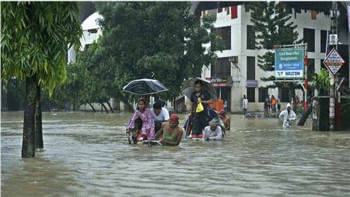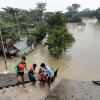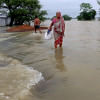Take steps before Sylhet flood turns devastating

The Eid holiday has not been the joyful experience that people in Sylhet and neighbouring areas probably expected it to be thanks to the evolving flood situation there. The region was just beginning to recover from the flash flood that hit on May 29 and lasted until about June 8. But any relief experienced was short-lived, as a second wave of flooding has hit the region amid Eid celebrations after torrential rains combined with onrush of water from upstream India. Reportedly, large parts of Sylhet and Sunamganj districts have been inundated, affecting lakhs of residents. With a forecast of continued rainfall over the next two days, the situation is likely to worsen further.
Sylhet is particularly vulnerable. According to the district administration, 21 out of the 42 wards in the city have been flooded. Additionally, floodwaters have entered 102 unions in all upazilas of the district, inundating a total of 1,323 villages. The situation in Sunamganj is no better, as major rivers in the two districts continue to swell. With many vital roads submerged, and neighbourhoods under knee-to-waist-deep water, life has come to a standstill. Power outages and communication disruptions could further complicate the situation.
Many are predicting a repeat or even exacerbation of the devastating flood situation that Sylhet had experienced in 2022. Driving this fear is the fact that in the first 18 days of this June, Sylhet recorded more rainfall than the entire month of June in 2022. The total rainfall by the end of this month might exceed 2,000 millimetres, according to an estimate, potentially setting a new record.
We don't need a reminder of the sufferings that this may result in. The authorities are doing what they can to help the affected but, clearly, they need to do more, both short-term and long-term. Beyond Sylhet, there are risks of flooding in a number of districts in Rangpur, Mymensingh, Barishal and Chattogram divisions. June, thus, is increasingly becoming a month of hardship caused by rains and mountain runoff. This is a challenge that goes beyond regular flood preparations, and with typical safeguards like embankments and polders too prone to damage, we must consider our long-term future.
There is an argument, increasingly pertinent, about whether relying on what worked in the pre-climate-change era can stand up to the more intense flooding seen these days. Should we continue to try containing the formidable rivers and deltaic nature of Bangladesh through often-fragile structural defences, or should we go for a blended approach that balances the restorative and destructive powers of floods through proper adaptations? We must explore these questions, and pursue solutions, with a more open mind. Right now, the priority is to respond properly to the fast-moving floods, particularly in Sylhet division, and minimise damage and suffering. The authorities must ensure that those stranded by water receive shelter, food, and drinking water.


 For all latest news, follow The Daily Star's Google News channel.
For all latest news, follow The Daily Star's Google News channel. 










Comments